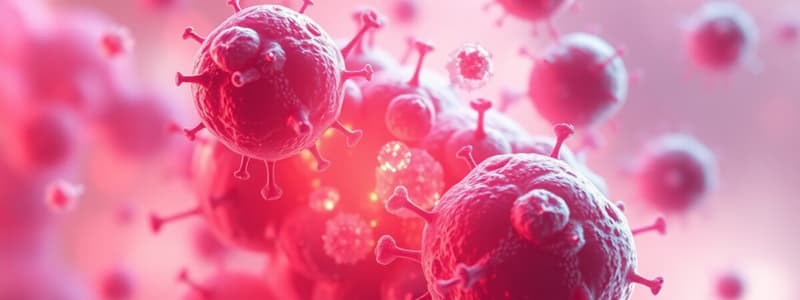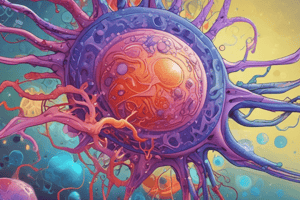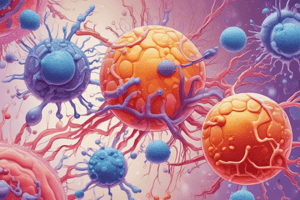Podcast
Questions and Answers
Which component on T cells is responsible for signal transduction?
Which component on T cells is responsible for signal transduction?
- CD4
- CD28
- CD3 and zeta protein (correct)
- TCR
What role does CD28 play in T cell activation?
What role does CD28 play in T cell activation?
- It acts as a co-stimulator binding to B7. (correct)
- It serves as a cytokine receptor.
- It stabilizes interaction with MHC.
- It signals apoptosis of T cells.
What cytokine is primarily responsible for Th1 differentiation?
What cytokine is primarily responsible for Th1 differentiation?
- IL-6
- IL-12 (correct)
- IL-4
- IL-2
What outcome occurs when T cells receive only signal 1 and lack signal 2?
What outcome occurs when T cells receive only signal 1 and lack signal 2?
Which component on APCs is involved in presenting antigens to T cells?
Which component on APCs is involved in presenting antigens to T cells?
How do activated T cells respond to IL-2?
How do activated T cells respond to IL-2?
What is the significance of co-stimulatory signals in T cell activation?
What is the significance of co-stimulatory signals in T cell activation?
What type of receptor do naïve T cells express before activation?
What type of receptor do naïve T cells express before activation?
What is the primary function of CD4+ T lymphocytes?
What is the primary function of CD4+ T lymphocytes?
Which phase follows the activation of T lymphocytes during cellular immune response?
Which phase follows the activation of T lymphocytes during cellular immune response?
What is NOT a type of naive CD4+ T lymphocyte?
What is NOT a type of naive CD4+ T lymphocyte?
What signals are essential for the activation of CD4+ T lymphocytes?
What signals are essential for the activation of CD4+ T lymphocytes?
Which statement correctly describes the role of CD8+ T lymphocytes?
Which statement correctly describes the role of CD8+ T lymphocytes?
Which stage of the cellular immune response results in the proliferation of antigen-specific T cells?
Which stage of the cellular immune response results in the proliferation of antigen-specific T cells?
Where does antigen recognition by naïve T lymphocytes primarily occur?
Where does antigen recognition by naïve T lymphocytes primarily occur?
Which of the following is a feature of memory T lymphocytes?
Which of the following is a feature of memory T lymphocytes?
Flashcards
Antigen Recognition
Antigen Recognition
Naïve T cells encounter antigens presented by antigen-presenting cells (APCs) in peripheral lymphoid organs.
Activation
Activation
T cells receive signals that trigger their activation, leading to proliferation and differentiation. This involves cytokine secretion and signaling.
Clonal Expansion
Clonal Expansion
Activated T cells multiply rapidly to create a large army of antigen-specific effector and memory T cells.
Differentiation
Differentiation
Signup and view all the flashcards
Effector Function
Effector Function
Signup and view all the flashcards
CD4+ T Cell Function
CD4+ T Cell Function
Signup and view all the flashcards
CD8+ T Cell Function
CD8+ T Cell Function
Signup and view all the flashcards
Memory T Cell Function
Memory T Cell Function
Signup and view all the flashcards
Signal 1: TCR-MHC Interaction
Signal 1: TCR-MHC Interaction
Signup and view all the flashcards
Signal 2: Co-receptor
Signal 2: Co-receptor
Signup and view all the flashcards
Signal 3: Co-stimulation
Signal 3: Co-stimulation
Signup and view all the flashcards
Stabilizing Interaction: Integrins
Stabilizing Interaction: Integrins
Signup and view all the flashcards
Signal 4: Cytokines
Signal 4: Cytokines
Signup and view all the flashcards
IL-2: Autocrine Signaling
IL-2: Autocrine Signaling
Signup and view all the flashcards
IL-7 vs. IL-2
IL-7 vs. IL-2
Signup and view all the flashcards
CD4+ and CD8+ T Cells
CD4+ and CD8+ T Cells
Signup and view all the flashcards
Study Notes
Cellular Immune Response I
- The lecture is about Cellular Immune Response I, specifically T lymphocytes responses.
- The writer is Ali Aljaziri and the reviewer is Faisal Aloraifi.
- The lecture covers the main phases of T lymphocyte responses.
- Antigen recognition by T lymphocytes, and the role of CD4, CD8, and adhesion molecules were discussed.
- Activation signals and co-stimulation molecules for CD4+ T lymphocytes were also detailed.
- The activation process of CD8+ T lymphocytes was explained.
- The functional responses and relevance of activated T lymphocytes were explored.
- Characteristics of memory T lymphocytes and the endpoint of the cellular immune response were covered.
- The migration of effector T lymphocytes to the infection site was discussed.
- The lecture covers various types of intracellular microbes combated by T cell-mediated immunity.
- T lymphocytes play a major role in cell-mediated immunity (CMI).
- CMI defends against infections by intracellular microbes through two types of infections.
- Firstly, phagocytes ingest microbes as part of the innate immune response.
- Some microbes resist phagocytosis.
- Pathogenic intracellular bacteria and protozoa survive and replicate within phagocytic vesicles.
- Viruses infect and replicate within the cytoplasm of cells.
- Examples of intracellular microbes were given (Mycobacteria, Listeria, Legionella, Cryptococcus, Leishmania, Trypanosoma, Plasmodium, Cryptosporidium, all Rickettsiae, and all viruses).
Lecture Outline
- The lecture outlined several topics including main phases of T lymphocytes responses
- Antigen recognition and role of CD4, CD8, and adhesion molecules.
- Activation signals and co-stimulation molecules for CD4+ T lymphocytes.
- Activation process of CD8+ T lymphocytes.
- Functional responses and relevance of activated T lymphocytes.
- Memory T lymphocytes and the endpoint of the cellular immune response.
- Migration of effector T lymphocytes to the infection site.
Importance
- The doctor emphasized that every objective is a question and the student should know the answer.
- The information contained was crucial for T-cell activation and function.
T-cell Activation
- T cells recognize antigens with TCR, CD3, and zeta protein.
- APC surface molecules (MHC I or II) are important for T-cell recognition.
- Important surface molecules from T-cells and corresponding ligands were explained.
- CD28 is a co-stimulatory receptor;
- CTLA-4 and PD-1 are inhibitory receptors on T cells.
- Co-receptors (CD4 or CD8) help stabilize interactions (signal 1) with MHC-associated peptide antigens.
Costimulation
- Costimulatory signals (signal 2) between cells is essential to prevent false alarms.
- T-cell activation requires a reciprocal and sequential signal 2 exchange between cells.
- A T-cell-APC interaction begins with TCR interaction with peptide/MHC complex.
- Signals, including cytokines, control T-cell differentiation (signal 3).
- The absence of co-stimulatory molecules causes T-cell anergy or apoptosis.
CD8 T-cell Activation
- CD8+ T cells are activated by APCs (dendritic cells).
- Infected tissue cells can also activate CD8+ T cells or function as a presentation site.
- Helper T cells play a crucial role in activating CD8 T-cells
- Cytokines from helper T cells promote CD8+ T cell differentiation/expansion.
Activation Pathways
- The biochemical pathway that connects antigen recognition with T-cell responses involves enzyme activation, adaptor protein recruitment, and transcription factor production.
- These pathways are initiated when the TCR interacts with MHC on APCs.
Memory T lymphocytes
- Memory T cells persist long after an infection is cleared.
- They are important for rapid immune responses upon re-exposure.
- Central memory cells reside in lymphoid organs and promote rapid expansion while effector memory cells are present at infection sites.
Effector T Cell Migration
- Naive T cells migrate through the bloodstream and lymphoid tissues.
- Effector T cells migrate to infection sites (specific to antigen).
- Adhesion molecules (L-selectin, Integrin) and chemokine receptors (CCR7) help with migration.
- T cell migration to the infection site is independent of antigen recognition.
Functional Responses
- Cytokine production
- Clonal expansion
- Differentiation into effector cells
- Differentiation of naïve CD4 T cells into effector cells (Tfh, Th1, Th2, Th17).
- Memory T cells also help with elimination of microbes via other mechanisms in addition to effector cells.
End Point of Cellular Immune Response
- The immune system returns to homeostasis.
- Excess T cells are eliminated through apoptosis.
- Only memory cells remain for quick response to future infections.
Studying That Suits You
Use AI to generate personalized quizzes and flashcards to suit your learning preferences.




